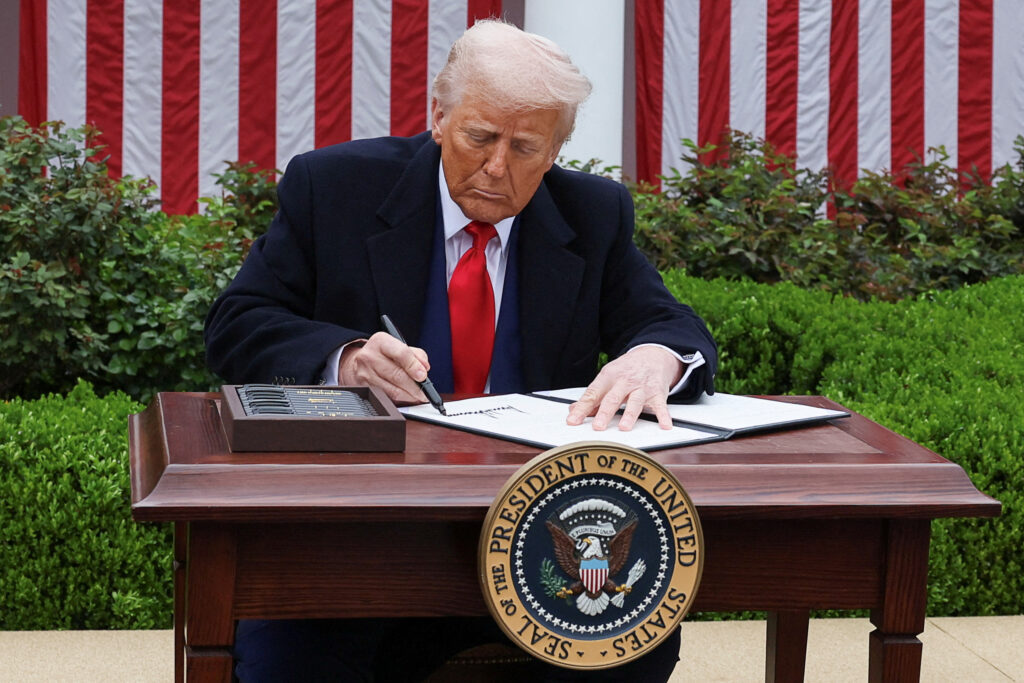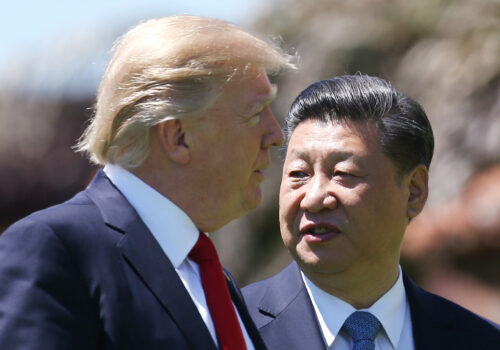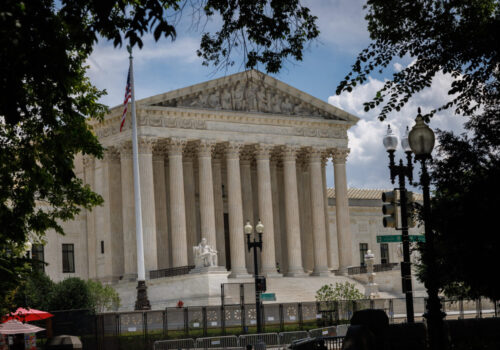Wednesday saw high drama in the highest court in the land, with oral arguments at the US Supreme Court over whether President Donald Trump is authorized to invoke the International Emergency Economic Powers Act (IEEPA) to impose sweeping tariffs on nearly all US imports.
If the tariffs—including measures targeting Mexico, Canada, and China over fentanyl imports—are upheld, it would confirm the executive branch’s unprecedented reach over economic policy. But if the court rejects the administration’s measures, the decision would limit the White House’s ability to move rapidly on some of its core strategic objectives.
Before the Supreme Court issues its verdict, it’s worth stepping back to assess the broader issues at play: What alternatives could the administration pursue if the court strikes down its use of IEEPA—and why has Trump relied on an aggressive tariff policy in the first place?
Alternative legal pathways exist—but they come with limitations
Even without IEEPA, the administration could rely on other legal instruments to replicate the intensity and scope of the current tariff environment. One alternative is Section 301 of the Trade Act of 1974. However, like all legislation explicitly granting the executive branch authority to levy tariffs or duties, Section 301 comes with constraints—particularly with regard to speed and applicability. Section 301 gives the US Trade Representative the authority to investigate and respond to foreign trade practices that violate trade agreements or disadvantage US commerce. After an investigation is complete, and if it affirms a trade partner’s unfair practices, the White House may impose tariffs on a range of products from that trading partner. However, it must first review petitions, hold public hearings, and issue findings before providing recommendations. In the past, this process has usually taken at least nine months. Unlike IEEPA, Section 301 duties cannot be applied instantly or without a comprehensive assessment.
Section 232 of the Trade Expansion Act of 1962 faces similar constraints in speed and scope. It gives the Commerce Department the authority to investigate whether the quantity or circumstances of specific imports pose national security risks, or could in the future. If such a risk is identified, the president can respond by imposing tariffs or quotas. Unlike Section 301, Section 232 authorizes tariffs on specific products from all US trading partners. While Section 232 involves fewer procedural steps than Section 301, it is limited in scope to products with national security implications. Notably, this limitation is flexible, as “national security” is broadly defined.
Meanwhile, Section 122 of the Trade Act of 1974 gives the president the authority to address significant balance-of-payments deficits through imposing temporary import tariffs of up to 15 percent. These tariffs can remain in place for 150 days unless extended by Congress. Actions must be applied on a nondiscriminatory basis to maintain the existing distribution of trade. However, the president can target specific countries by exempting others. Section 122 has never been used to levy tariffs and is clearly constrained in both duty level and the duration of measures.
Section 338 of the Tariff Act of 1930 allows the president to impose additional duties on countries engaging in discriminatory trade practices against the United States. These practices must uniquely disadvantage US exporters and not be universally applied. If applicable, the president may impose tariffs of up to 50 percent of the imported product’s value—and persistent discrimination may allow the blocking of all imports from the offending country. Section 338 has also never been invoked and is limited to responses to unfair trade practices.
Generating revenue and countering trade imbalances without IEEPA
It is worth remembering that Trump has wielded tariffs for four distinct purposes: to generate revenue, balance nontariff barriers imposed by trading partners, punish adversaries for practices often unrelated to trade, and serve as a negotiation tool. If the Supreme Court rules against Trump’s claim of unilateral power to impose tariffs, these objectives would be jeopardized, but not unachievable.
A majority of the additional tariff revenue collected, for instance, would theoretically need to be refunded to importers, potentially as a future credit. One alternative the administration could use to raise revenue in 2026 would be leveraging Section 301 to impose tariffs on major US trading partners such as China, Canada and Mexico (for goods not compliant with the United States-Mexico-Canada Agreement), and the European Union.
However, Section 301 cannot be used to generate revenue, only to counter unfair trade practices. Without linking tariffs to addressing unfair trade, these measures could be vulnerable to legal challenges if the Supreme Court rules that revenue-generating tariffs must originate in Congress. The White House initiated a Section 301 investigation on China in October and could pursue new investigations against other major trading partners. The graph below illustrates the US import value potentially exposed to Section 301 tariffs for the United States’ top ten trading partners if applying current IEEPA tariff rates. The White House clearly does not need global tariffs to raise revenue.
The administration could also expand Section 232 tariffs—as it is already likely to do on pharmaceuticals, critical minerals, and semiconductors. Thanks to the broad definition of national security, the White House has already expanded the lists of products subject to Section 232 tariffs to include many derivative products, such as bathroom vanities, which do not present obvious national security concerns. The value of US imports exposed to the Section 232 tariffs added just in Trump’s second term are already comparable to that of the IEEPA tariffs, suggesting that the revenue collected could also be comparable.
To compensate for the 10 percent global baseline tariff, the administration could use Section 122 to levy up to a 15 percent baseline tariff on all economies with large and sustained trade deficits. This approach, however, rests on a weaker legal foundation than Sections 232 and 301 and would likely face court challenges.
Overall, the administration has sufficient tools at its disposal to achieve comparable tariff revenue in coming years, even if invoking IEEPA is no longer an option.
Targeting unfair trade through Section 301 and sanctions
When it comes to using tariffs as a punitive tool for grievances, the administration has applied this tactic mostly to trade unrelated to IEEPA. For example, a 40 percent tariff was imposed on imports from Brazil due to “policies, practices, and actions of the Government of Brazil” threatening US national security, foreign policy, and economic interests. The United States also added a 25 percent tariff on imports from India because of its continued imports of Russian oil. This strategy is likely to falter without IEEPA, which allows tariffs to be applied instantaneously.
Using Section 301 could potentially replace this strategy with regard to country-focused actions, but it requires a comprehensive review and must address unfair trade practices. For countries such as Brazil, with which the United States maintains a trade surplus, defending such tariffs legally may be more difficult, although investigations are already underway. Moreover, the administration could also rely on traditional national security tools, such as sanctions, instead of tariffs.
The tariff regime may hold, but negotiating power could wane
Meanwhile, the administration’s use of tariffs as a negotiation tool would be substantially weakened without IEEPA. After all, even after deals are agreed upon, enforcement is critical. As US Trade Representative Jamieson Greer wrote in the New York Times, “the new U.S. approach is to closely monitor implementation of the deals and swiftly reimpose a higher tariff rate for noncompliance if needed.” The emphasis is on “swiftly reimpose.”
If the administration must rely on Section 301 or Section 232 to target economies or key industries, the penalty for noncompliance would be much slower than with IEEPA. Section 122 or 338 could be experimented with, but countries may perceive these alternatives as less credible, especially if the Supreme Court has already ruled against the administration regarding IEEPA.
If the administration’s primary objective is to preserve tariff revenue and counter unfair practices, sections 301, 232, or 122 remain viable alternatives. While slower and more constrained, these tools can replicate the current tariff regime. However, if the goal is to secure new trade agreements or enforce compliance, the absence of IEEPA is likely to diminish both credibility and speed, weakening the administration’s negotiating power.
Sophia Busch is an associate director at the Atlantic Council’s GeoEconomics Center.
Further reading
Fri, Nov 7, 2025
Pharmaceuticals are China’s next trade weapon
Sinographs By Niels Graham
China supplies most critical drug ingredients to the US, and the dependency is only growing. After the rare earths truce, pharma is an area to watch.
Sun, Oct 12, 2025
As the trade war resumes, China may be keeping one eye on Trump and one on the Supreme Court
New Atlanticist By Josh Lipsky
The US president’s leverage with Xi Jinping could be undercut by the Supreme Court's deliberations.
Wed, Nov 5, 2025
How might the Supreme Court reshape Trump’s tariffs?
Fast Thinking By
The Supreme Court expressed skepticism of the Trump administration’s sweeping tariff authority during oral arguments on Wednesday.
Image: US President Donald Trump signs an executive order on tariffs, in the Rose Garden at the White House in Washington, D.C., U.S., April 2, 2025. REUTERS/Leah Millis/File Photo





